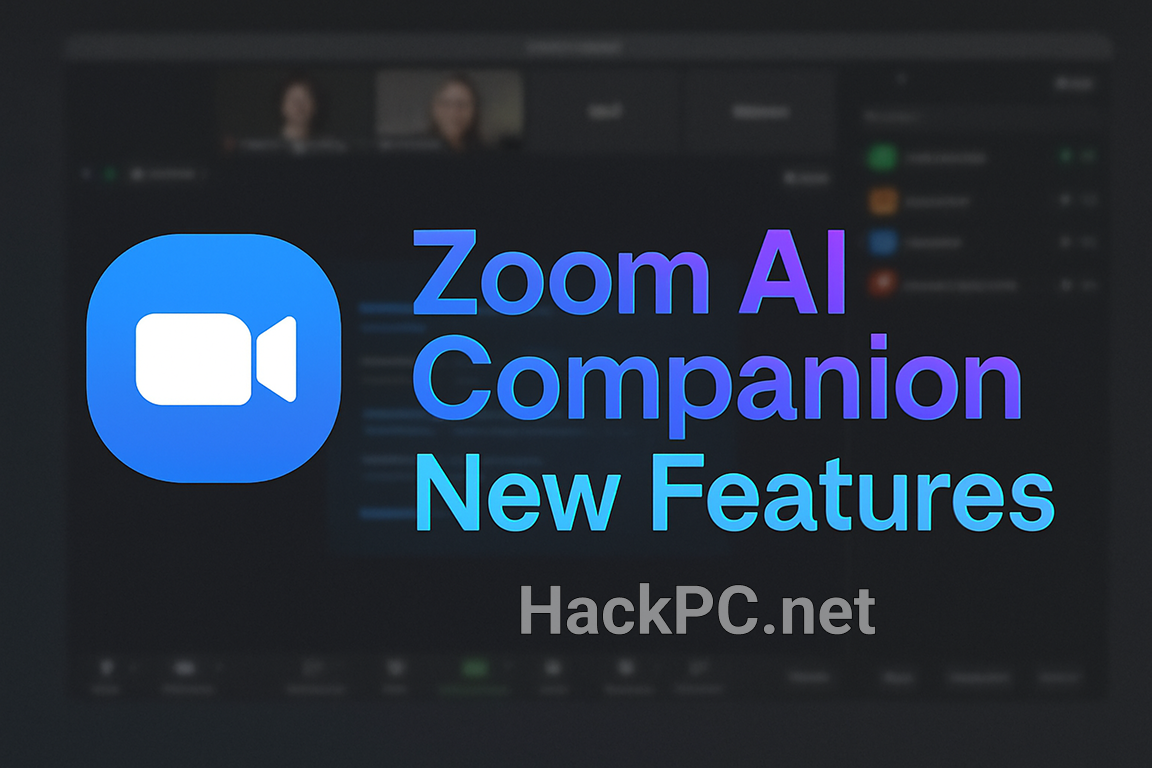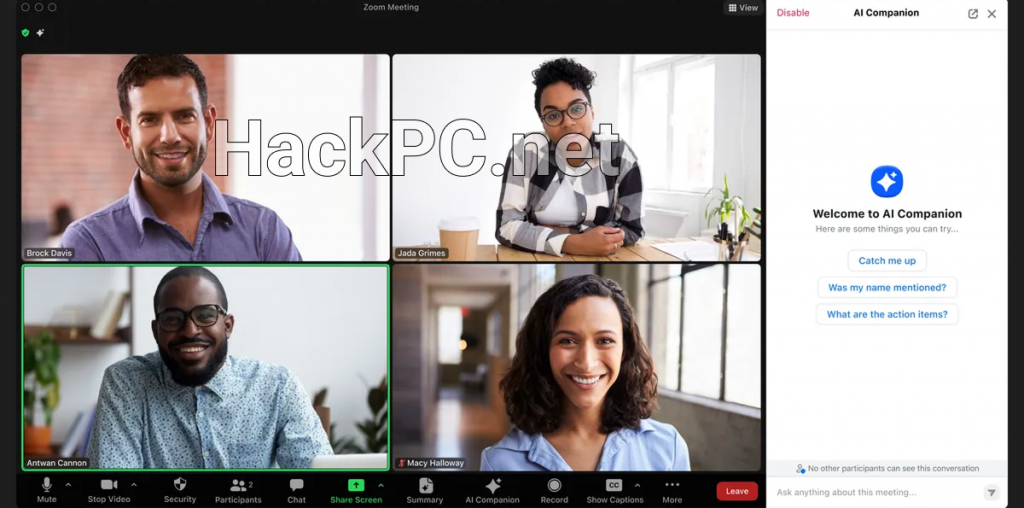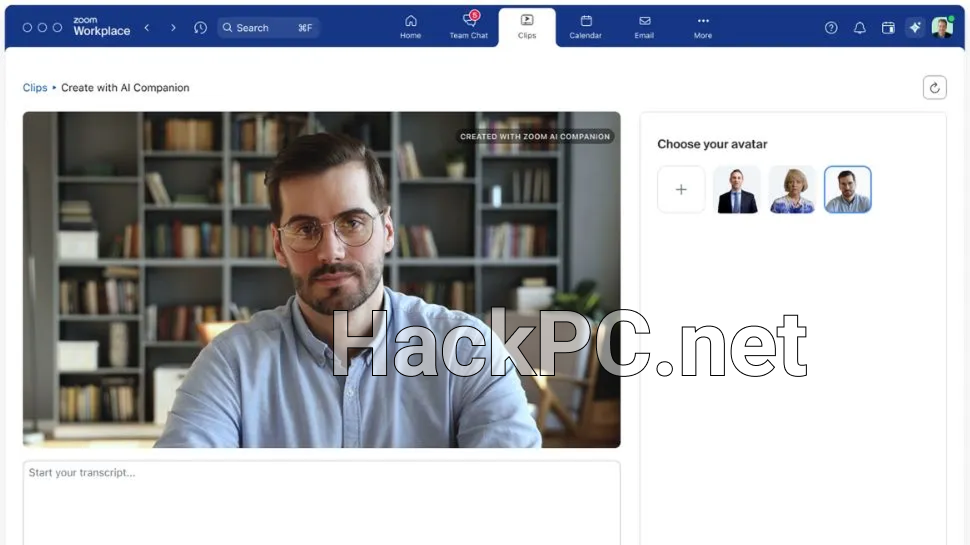
Executive Summary: The Shift to Truly Autonomous AI
Zoom AI Companion expands agentic skills across the entire Zoom platform, using reasoning and memory to take action and orchestrate task execution, conversational self-service, custom agent creation, and more. This comprehensive news overview examines Zoom’s aggressive push into agentic AI territory, analyzing the latest feature announcements from March 2025 and the October 2024 Zoomtopia event that fundamentally reshape how businesses approach AI-powered collaboration.
The platform’s evolution from a simple meeting assistant to a sophisticated autonomous agent system represents both technological advancement and complex questions about workplace automation’s future trajectory.
The March 2025 Expansion: Agentic AI Takes Center Stage
Core Agentic Capabilities Announcement
Zoom AI Companion is agentic! Zoom customers can now experience even greater productivity through the addition of agentic AI skills, agents, and models as we elevate AI Companion across our entire platform. This pivotal announcement marks Zoom’s transition from reactive AI assistance to proactive autonomous execution.
Key Technical Enhancements:
- Advanced reasoning engine with memory persistence
- Multi-agent orchestration capabilities
- Task execution without human intervention
- Context-aware decision-making frameworks
- Learning algorithms that adapt to organizational patterns
New Feature Rollout Timeline
Immediate Availability (March 2025):
- Dynamic voicemail greetings with AI-generated personalized messages
- Real-time phone call summaries and question handling
- Enhanced Zoom Rooms customization with NDI, Dante support
- Mail and package management for hybrid workspaces
Near-Term Releases (April-July 2025):
- Custom AI Companion add-on launch ($12/user/month)
- Automatic data table creation from meeting summaries
- Zoom Drive central repository (May 2025)
- Industry-specific solutions for frontline, healthcare, and education
Critical Analysis: While the feature density is impressive, the rapid rollout raises questions about testing thoroughness and potential integration complexities. Organizations may struggle to keep pace with the constant feature evolution, potentially leading to underutilization of capabilities.

AI Companion 2.0: Architecture and Technical Implementation
The Federated AI Approach
Zoom’s federated approach to AI, which allows its tech stack to dynamically select from multiple AI models, including those from OpenAI, Anthropic, and Meta, and AI services such as Perplexity.ai. This multi-model strategy represents sophisticated engineering but introduces complexity in performance consistency and debugging.
Technical Architecture Components:
- Large Language Models (LLMs) for natural language processing
- Small Language Models (SLMs) for specialized, high-accuracy tasks
- Dynamic model selection based on task requirements
- Integration layer for third-party AI services
- Custom training capabilities through AI Studio
Memory and Context Management
The platform’s ability to maintain conversation context across sessions introduces both powerful capabilities and privacy considerations:
Strengths:
- Persistent memory across interactions
- Cross-application context awareness
- Personalized response generation
- Historical learning from user patterns
Concerns:
- Data retention policies unclear for long-term memory
- Potential for context pollution in shared environments
- Privacy implications of persistent behavioral tracking
- Complexity in managing context boundaries
Custom AI Companion Add-On: Enterprise Personalization at Scale
Technical Capabilities
The custom add-on, priced at $12 per user monthly, offers substantial customization potential:
Configuration Options:
- Company-specific vocabulary integration
- Custom knowledge base incorporation
- Workflow-specific agent creation
- Industry terminology adaptation
- Role-based behavior modification
Implementation Considerations: The pricing model appears competitive compared to enterprise AI solutions, but organizations must evaluate:
- Training data requirements for effective customization
- Ongoing maintenance overhead for custom models
- Integration complexity with existing systems
- ROI measurement challenges for AI customization
Small Language Models Integration
The company said its add-on capabilities incorporate AI small language models alongside large language models to provide high-accuracy answers at a low cost. This hybrid approach demonstrates technical sophistication:
Advantages:
- Reduced computational overhead for specific tasks
- Higher accuracy in domain-specific operations
- Cost-effective scaling for enterprise deployment
- Faster response times for targeted queries
Trade-offs:
- Increased architectural complexity
- Potential inconsistency between model outputs
- Challenging debugging across multiple model types
- Training coordination requirements
Industry-Specific Solutions: Vertical Market Penetration
Workplace for Frontline Workers
The frontline solution addresses a traditionally underserved market segment with:
- Push-to-talk functionality
- Shift management automation
- Task coordination systems
- Mobile-first design philosophy
Critical Assessment: While addressing real needs, the solution faces adoption challenges in environments with limited digital literacy and infrastructure constraints.
Workplace for Clinicians
Healthcare-specific features launching March 2025:
- Documentation automation
- Administrative task offloading
- HIPAA compliance considerations (notably, still restricted)
- Patient interaction summaries
Regulatory Challenges: The continued restriction of AI features in HIPAA-compliant instances highlights unresolved regulatory complexities that may limit healthcare adoption.
Workplace for Education
Zoom Workplace for Education will provide AI Companion-generated lecture summaries with supporting material that teachers can use to generate assignments and students can use to create study materials.
Educational Technology Integration:
- Live notes with student interaction capabilities
- Assignment generation from lecture content
- Study material creation automation
- Curriculum planning assistance
Pedagogical Considerations: The automation of educational content creation raises questions about academic integrity and the role of AI in learning assessment.
Technical Infrastructure Updates
Zoom Rooms Evolution
The platform’s hardware ecosystem receives significant updates:
- Custom AV protocols for Windows and macOS
- SDK and API expansion for integrators
- Smart speaker tags for identification
- Document camera certification for education
Infrastructure Analysis: These updates position Zoom to compete more effectively with traditional AV solutions while maintaining software-first flexibility.
Admin Dashboard Intelligence
Features of the dashboard will include: A bird’s eye view of Zoom Workplace usage and utilization across the organization. AI-based recommendations to optimize Zoom Workplace deployments.
Administrative Capabilities:
- AI-powered deployment optimization
- Usage analytics with predictive insights
- Natural language query interface
- Automated report generation
Performance Metrics and Real-World Impact
Adoption Statistics
Since launching in September 2023, AI Companion has been enabled on more than 4 million accounts. This rapid adoption suggests market acceptance but requires deeper analysis:
Success Indicators:
- Broad enterprise adoption across sectors
- Positive user feedback on time savings
- Integration success with existing workflows
- Measurable productivity improvements
Areas Requiring Scrutiny:
- Actual usage versus enablement rates
- Feature utilization depth
- Long-term retention metrics
- Comparative performance against competitors
Customer Testimonials Analysis
Educational institutions report transformation in operations, but testimonials require critical examination:
- Selection bias in published testimonials
- Lack of quantitative performance metrics
- Absence of failure case studies
- Limited long-term usage data
Competitive Landscape Analysis
Market Positioning
Zoom’s aggressive feature expansion positions it uniquely:
- Free inclusion with paid plans versus competitor add-on pricing
- Broader platform integration than specialized AI tools
- Faster feature velocity than traditional collaboration platforms
Competitive Vulnerabilities
Despite advantages, several challenges remain:
- Microsoft’s deeper enterprise integration
- Google’s superior AI research capabilities
- Specialized tools’ focused excellence
- Open-source alternatives’ customization flexibility
Privacy and Security: A Nuanced Perspective
Data Handling Commitments
Zoom does not use any customer audio, video, chat, screen sharing, attachments, or other communications-like customer content to train Zoom’s or its third-party artificial intelligence models.
Privacy Strengths:
- Clear data usage boundaries
- No training on customer content
- Administrative control granularity
- Transparent privacy documentation
Remaining Concerns:
- Third-party AI service data handling
- Cross-border data processing implications
- Long-term data retention policies
- Incident response procedures for AI-related breaches

Future Trajectory: Technical Roadmap Analysis
Near-Term Development Focus
The announced roadmap reveals strategic priorities:
- ServiceNow integration for enterprise workflow
- Expanded third-party agent ecosystem
- Enhanced multi-agent collaboration
- Custom agent marketplace potential
Long-Term Strategic Questions
Several critical questions remain unanswered:
- Sustainability of free AI inclusion model
- Scalability of compute-intensive features
- Regulatory compliance evolution
- Market consolidation impact
Implementation Recommendations
For Enterprise Adopters
Phased Rollout Strategy:
- Begin with meeting summarization features
- Gradually introduce agentic capabilities
- Evaluate custom add-on ROI carefully
- Monitor user adoption patterns closely
Risk Mitigation:
- Establish clear AI usage policies
- Implement feature governance frameworks
- Regular privacy impact assessments
- Continuous user training programs
For Individual Users
Optimization Approach:
- Master core features before exploring advanced capabilities
- Understand privacy implications thoroughly
- Provide feedback for continuous improvement
- Monitor personal productivity metrics
Critical Assessment: Promise Versus Reality
Technological Achievement
Zoom’s AI implementation represents genuine innovation:
- Sophisticated multi-model orchestration
- Impressive feature velocity
- Strong platform integration
- Competitive pricing strategy
Implementation Challenges
However, several concerns merit consideration:
- Feature overload potentially overwhelming users
- Quality consistency across rapid releases
- Support infrastructure scaling challenges
- Integration complexity for enterprise environments
Market Impact Analysis
Industry Transformation Potential
The platform’s evolution could fundamentally alter:
- Meeting culture and documentation practices
- Administrative overhead in organizations
- Accessibility for global teams
- Competitive dynamics in collaboration space
Adoption Barriers
Despite potential, significant barriers remain:
- Change management complexity
- Training requirements at scale
- Privacy concerns in regulated industries
- Technical infrastructure prerequisites
Conclusion: A Pivotal Moment in Collaboration Evolution
Zoom AI Companion’s latest features represent both remarkable technological progress and complex organizational challenges. The platform’s transition to truly agentic AI capabilities positions it at the forefront of workplace automation, yet success depends on careful implementation and realistic expectations.
The aggressive feature rollout demonstrates Zoom’s commitment to AI leadership but raises questions about sustainable development pace and quality assurance. Organizations must balance enthusiasm for productivity gains against thoughtful consideration of privacy, training, and integration requirements.
While the free inclusion model provides compelling value, the true test lies in real-world adoption depth and long-term sustainability. As the collaboration landscape continues evolving rapidly, Zoom’s AI-first strategy represents a bold bet on autonomous assistance becoming essential to modern work.
The platform stands at an inflection point: technical capabilities have matured sufficiently to deliver genuine value, yet human and organizational factors will ultimately determine success. For organizations willing to navigate the complexity, Zoom AI Companion offers transformative potential. For those seeking stability and simplicity, the rapid evolution may prove overwhelming.
This moment demands careful evaluation, strategic planning, and realistic expectations. The future of work may indeed be agentic, but the path forward requires thoughtful navigation of both technological promise and practical constraints.



Comments (0)